The Huc Bridge: Hanoi's Iconic Red Bridge Connecting Culture and History
In the heart of Vietnam's capital, where ancient traditions blend seamlessly with modern life, stands a structure that has become synonymous with Hanoi's cultural identity. The Huc Bridge—a vibrant red wooden bridge arching gracefully over the emerald waters of Hoan Kiem Lake—is much more than just a picturesque crossing. It's a historical landmark, a cultural symbol, and a spiritual gateway that has captured the hearts of locals and visitors alike for generations.
A Bridge with Profound Meaning
The Huc Bridge isn't just a physical connection between the lakeshore and Jade Island; it's a bridge laden with symbolism and cultural significance. Its very name—"Thê Húc" in Vietnamese—carries deep meaning, variously translated as "Morning Sunlight Bridge," "Where Light is Caught," or "Accumulation of Light," reflecting its eastward orientation that welcomes the first rays of the morning sun. This positioning was deliberately chosen to capture positive energy and vitality from nature, in keeping with traditional Vietnamese beliefs.

The Huc Bridge represents spiritual awakening, scholarly aspirations, and the transition from the secular to the sacred - Photo Source: Facebook Hà Nội Fan
The bridge serves as the sole pathway to the revered Ngoc Son Temple (Temple of the Jade Mountain), a sacred site dedicated to literary and military excellence through worship of Van Xuong De Quan (the deity of literature and civil examinations) and the national hero Tran Hung Dao. This connection transforms The Huc Bridge from a mere passageway into a symbolic transition—from the bustling secular world of Hanoi's streets to the sacred, contemplative space of the ancient temple.
Cultural Echoes: More Than Just a Bridge
The Huc Bridge is widely recognized as an important symbol of Hanoi's culture, history, and identity. It has been likened to "precious jewelry of Hoan Kiem Lake," emphasizing its role in adorning and completing the lake's beauty.
The bridge's role as a gateway to the spiritual space of Ngoc Son Temple is a crucial aspect of its cultural significance. With the temple dedicated to Van Xuong De Quan (the deity of scholarship) and Tran Hung Dao (national hero), the bridge becomes part of a spiritual journey for those coming to pray, seek good fortune, or express reverence.
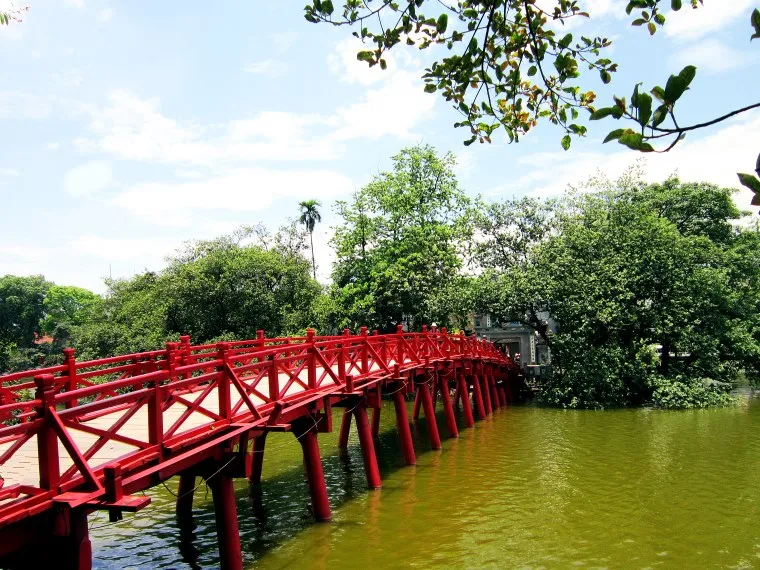
Deeply embedded in folk culture and symbolism, the bridge embodies Hanoi’s spiritual life, historical memory, and aesthetic ideals - Photo Source: Wikipedia
Through its name ("Thê Húc") and color (red), the bridge embodies aspirations for light, knowledge, life, happiness, and good fortune. Its eastern orientation further reinforces connections with beginnings, renewal, and hope.
The Huc Bridge has entered popular culture and collective memory, captured in famous folk verses linking images of the bridge with Hoan Kiem Lake and Ngoc Son Temple. The bridge's image, often described as a "red silk strip" or "red silk band," is a common poetic description, reflecting its graceful, delicate beauty.
The bridge serves as a tangible structure connecting people with intangible heritage aspects: spiritual beliefs, historical reverence (for figures like Tran Hung Dao), cultural symbols (color, direction), and collective memory (folk verses). Crossing the bridge is not merely a physical act but an opportunity to engage with these deeper layers of heritage, as it leads to a place of worship, its design elements are full of symbolic meaning, and its presence in folk culture shows its integration into the spiritual life of the people.
Essential Guide for Visitors
Quick Facts:
-
Name: The Huc Bridge (Cầu Thê Húc)
-
Meaning: "Where Morning Sunlight Rests," "Where Light Gathers," "Accumulation of Light"
-
Location: Hoan Kiem Lake, Hoan Kiem District, Hanoi, Vietnam. Connects Dinh Tien Hoang Street area to Ngoc Son Temple on Jade Island.
-
Construction Year: 1865 by Nguyen Van Sieu
-
Architecture: Curved wooden bridge painted red; 15 spans, 32 columns (16 pairs); concrete foundations (since 1953). Approximately 45m long.
-
Major Renovations: Late 19th century (around 1886-1897), 1952-1953 (rebuilt after collapse incident)
Practical Information for Tourists:
Transportation: The Huc Bridge can be reached by taxi, ride-hailing services, motorbike (parking available nearby), cyclo, or public buses (routes such as 04, 08, 09, 11, 14, 23, 34, 40 are mentioned). The Hoan Kiem Lake area becomes a pedestrian zone on weekends, making it convenient for sightseeing.
Opening Hours & Admission Fees:
-
The Huc Bridge: Observable 24/7. Access to the bridge may follow Ngoc Son Temple opening hours. Viewing the bridge is free.
-
Ngoc Son Temple: Requires an entrance ticket (Adults: 30,000 VND; Students: 15,000 VND; Children under 15: Free). Common opening hours are 7:00 AM - 6:00 PM (Monday-Friday) and 7:00 AM - 9:00 PM (Saturday-Sunday). (Note: It's advisable to check information on-site for the most up-to-date details.)
Visitor Summary Table:
|
Attraction |
Location |
Visiting Hours (Reference) |
Admission Fee (Reference) |
Notes |
|
The Huc Bridge |
Hoan Kiem Lake, leads to Ngoc Son Temple |
Observable 24/7. Access may follow Temple hours. |
Free |
Famous photography spot. |
|
Ngoc Son Temple |
Jade Island, accessible via The Huc Bridge |
Mon-Fri: 7:00 AM-6:00 PM; Sat-Sun: 7:00 AM-9:00 PM (Check on-site) |
Adults: 30,000 VND; Children: Free |
Sacred worship site; dress respectfully. Includes Pen Tower, Ink Slab... |
Everything travelers need to know about visiting The Huc Bridge, including history, structure, access, hours, and fees - Photo Source: Báo Lao Động
Nearby Attractions:
-
Ngoc Son Temple: Inside features the main worship hall, Tran Ba pavilion, Dac Nguyet Lau gate. Displays a preserved specimen of the giant softshell turtle.
-
Hoan Kiem Lake: The lake itself is an ideal place for walking, relaxing, sightseeing, and observing local life.
-
Turtle Tower: Iconic tower located on a separate islet in the middle of the lake.
-
Pen Tower & Ink Slab: Located at the entrance area of The Huc Bridge/Ngoc Son Temple. Symbolizing literature and scholarship.
-
Hanoi Old Quarter: Located right next to the lake, with ancient streets, diverse shops, and rich cuisine.
-
Ly Thai To Garden: Nearby park with a statue of King Ly Thai To.
-
St. Joseph's Cathedral: Within walking distance from the lake area.
-
Thu Le Park Hanoi: If you're traveling with children or simply want a break from the historical bustle, Thu Le Park Hanoi offers a refreshing green oasis combined with a small zoo - ideal for a laid-back afternoon.
-
For those seeking a more immersive cultural escape, a day trip to Duong Lam Ancient Village in Hanoi promises a step back in time. With its laterite houses, centuries-old temples, and tranquil rural atmosphere, it's a fascinating glimpse into Vietnam’s traditional village life.
Interesting Details and Photography Tips:
Best Time for Photography: Early morning to experience the meaning of "Thê Húc" (greeting the sunlight). Evening when the bridge is illuminated, reflecting on the lake surface. Weekends when the surrounding area becomes a walking street.
Popular Photography Spot: The bridge is a highly favored location for photography, especially for wedding photos and portraits (often with traditional ao dai attire).
Unique Angles: Shots can be taken from the lakeside promenade, from inside Ngoc Son Temple looking outward, or from cafes with views of the lake.
Cultural Note: When entering Ngoc Son Temple, dress respectfully, modestly, maintain silence, and refrain from taking photographs inside the main worship hall.
The Perfect Itinerary: Experiencing The Huc Bridge
To truly appreciate The Huc Bridge and its surroundings, consider this suggested itinerary:
Morning Visit (7:00 AM - 10:00 AM)
Start your day early at Hoan Kiem Lake, when the morning light bathes The Huc Bridge in golden hues—exactly as its name "Morning Sunlight Bridge" suggests. This early hour offers two advantages: experiencing the bridge in its most symbolic light and avoiding the crowds that gather later in the day.
Begin by walking around the lake's eastern shore, capturing photos of the bridge from different angles as the sun rises behind it. The red color appears particularly vibrant against the morning sky, creating perfect photo opportunities.
Cross The Huc Bridge to visit Ngoc Son Temple when it opens at 7:00 AM. Take your time exploring the temple complex, including the worship hall, historic artifacts, and the preserved giant turtle specimen. The temple is typically less crowded in the morning, allowing for a more peaceful experience of this sacred space.
Afterward, enjoy a traditional Hanoi breakfast at one of the nearby cafes or street food vendors. Consider trying "pho" (noodle soup) or "banh mi" (Vietnamese sandwich) while watching the city come to life around the lake.
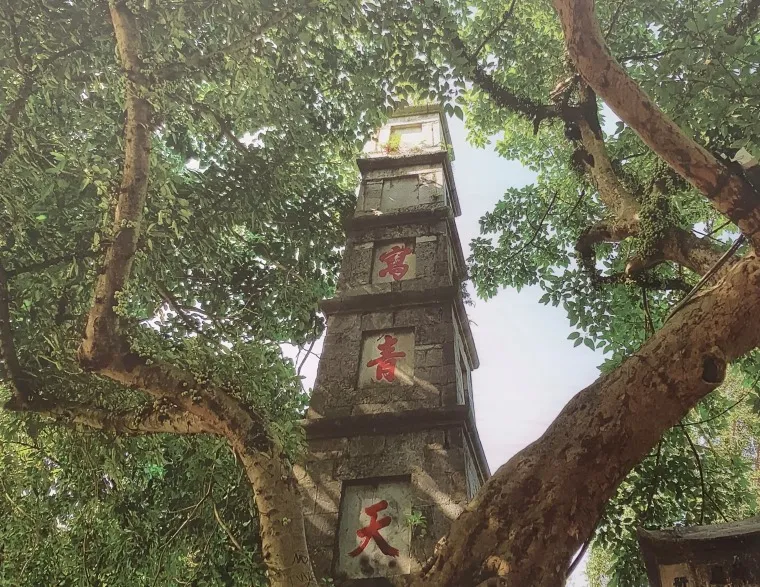
A suggested day plan helps visitors experience the bridge’s beauty and symbolism from dawn till evening - Photo Source: Báo Lao Động
Afternoon Explorations (2:00 PM - 5:00 PM)
Return to The Huc Bridge in the afternoon for a different perspective. The midday light creates strong contrasts that highlight the bridge's architectural details. Take time to observe the 15 spans and 32 pillars that form this engineering marvel.
From the bridge, enjoy panoramic views of Hoan Kiem Lake and the surrounding urban landscape. On clear days, you can see the contrast between Hanoi's historical buildings and modern developments from this vantage point.
Combine your visit with exploration of the nearby Old Quarter, just a short walk from the northern shore of the lake. The ancient streets, each traditionally named after the goods once sold there, offer countless opportunities for shopping, cultural immersion, and photography.
Evening Experience (6:00 PM - 9:00 PM)
The Huc Bridge is perhaps at its most magical in the evening, especially on weekends when the surrounding streets become a pedestrian zone filled with performances, games, and food stalls. As darkness falls, the bridge is illuminated, creating a mesmerizing reflection in the calm waters of the lake.
If visiting on a weekend, Ngoc Son Temple remains open until 9:00 PM, offering a rare opportunity to experience the temple and bridge under evening illumination. The temple takes on a mystical quality at night, with lanterns and lights creating a serene atmosphere.
Complete your experience with dinner at one of the restaurants overlooking the lake, where you can continue to admire The Huc Bridge while sampling Northern Vietnamese cuisine. Popular dishes in this area include "bun cha" (grilled pork with rice noodles) and "cha ca" (turmeric-marinated fish).
The Bridge Through the Seasons
The Huc Bridge presents different faces throughout the year, each season offering unique experiences for visitors:
Spring (February - April)
Spring brings mild temperatures and occasional light rain to Hanoi, creating misty mornings where The Huc Bridge emerges dramatically from the fog. This is also when many traditional festivals take place, particularly around Lunar New Year, when the bridge and surrounding areas are decorated with flowers and lanterns. The bridge often becomes busy with worshippers visiting Ngoc Son Temple to pray for good fortune in the new year.
Summer (May - September)
Summer in Hanoi is characterized by heat, humidity, and afternoon thunderstorms. Morning visits are recommended to avoid both the heat and potential rain. The intense summer sunlight makes the bridge's red color particularly vibrant against the deep green of the lake. Evening visits are especially pleasant, as the cooler temperatures bring locals and visitors to the lakeside for relief from the day's heat.
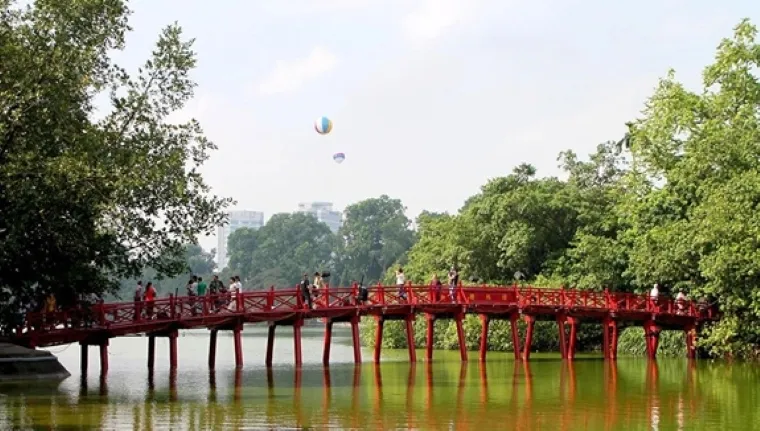
Each season offers a unique visual and cultural experience of The Huc Bridge, from misty spring mornings to autumn’s golden glow - Photo Source: Website hanoi.qdnd.vn
Autumn (October - November)
Many consider autumn the most beautiful season to experience The Huc Bridge. The weather is mild and dry, with clear blue skies that create a stunning backdrop for the red bridge. The quality of light during Hanoi's autumn months is exceptional, with golden afternoons that photographers particularly treasure. This is generally considered the ideal season for photography at the bridge.
Winter (December - January)
Winter brings cooler temperatures and sometimes foggy conditions to Hanoi. On clear winter days, the stark light creates dramatic shadows on the bridge's architecture. On misty mornings, the bridge appears to float ethereally above the lake's surface. Winter evenings can be chilly, but the bridge and temple are less crowded during this season, offering a more contemplative experience.
Conclusion: A Symbol That Transcends Time
The Huc Bridge is far more than a simple crossing; it is a living symbol of Hanoi's soul. As a physical structure, it demonstrates the elegant integration of function and beauty that characterizes Vietnamese traditional architecture. As a cultural icon, it embodies connections between past and present, between the secular and the sacred, between daily life and spiritual aspiration.
For visitors to Hanoi, The Huc Bridge offers a perfect entry point to understanding the city's character—its reverence for history, its aesthetic sensibilities, its spiritual dimensions, and its ability to preserve tradition amid rapid change. The simple act of crossing this bridge connects today's visitors with countless generations who have made the same journey, creating a profound sense of continuity with Hanoi's rich past.
Whether illuminated by the morning sun that gave it its name, reflecting in the calm waters of the lake at midday, or glowing under evening lights as locals gather around its shores, The Huc Bridge remains an enduring emblem of Hanoi's beauty and cultural heritage—a crimson thread weaving together the many layers of the city's fascinating story.
With a well-planned itinerary, budget-friendly options, and an open mind to meeting new people, your solo journey will be both fulfilling and exciting. Let Joytime be your trusted companion, providing essential travel gear to ensure comfort, safety, and convenience throughout your trip. An incredible solo adventure awaits—pack your bags and explore Hanoi with confidence!
|
Joytime Travel Agency- Travel JOY, TIMEless Vietnam Follow us for travel tips, local insights, and exclusive offers:
|
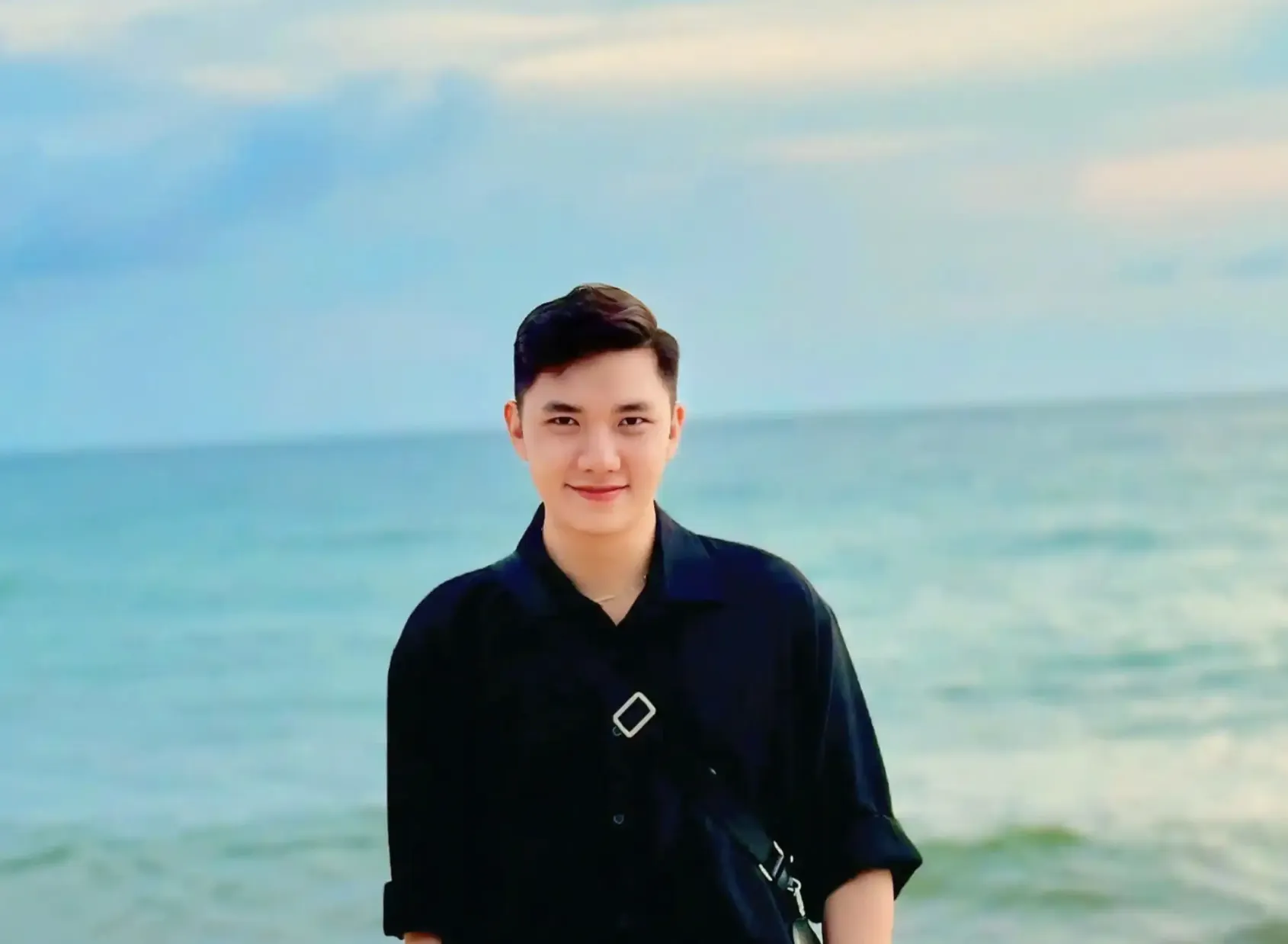
Danish Nguyen
Danish Nguyen is a renowned travel blogger in Vietnam with over 5 years of experience sharing unique travel experiences. With a passion for exploring new places, Danish captures incredible moments and provides readers with valuable tips to discover the beauty of his homeland.



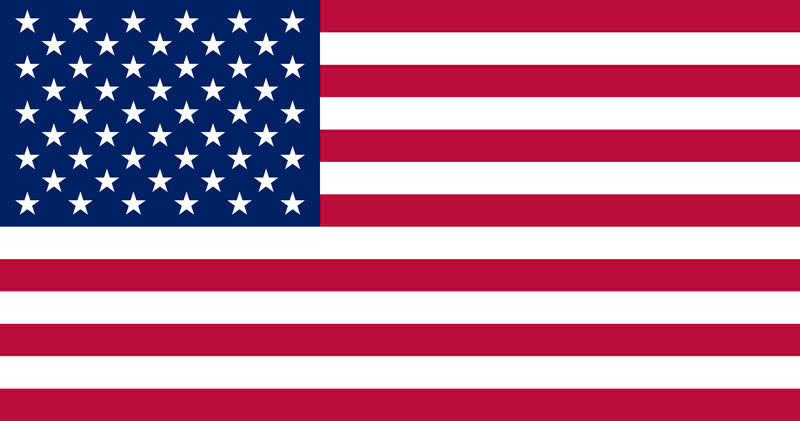

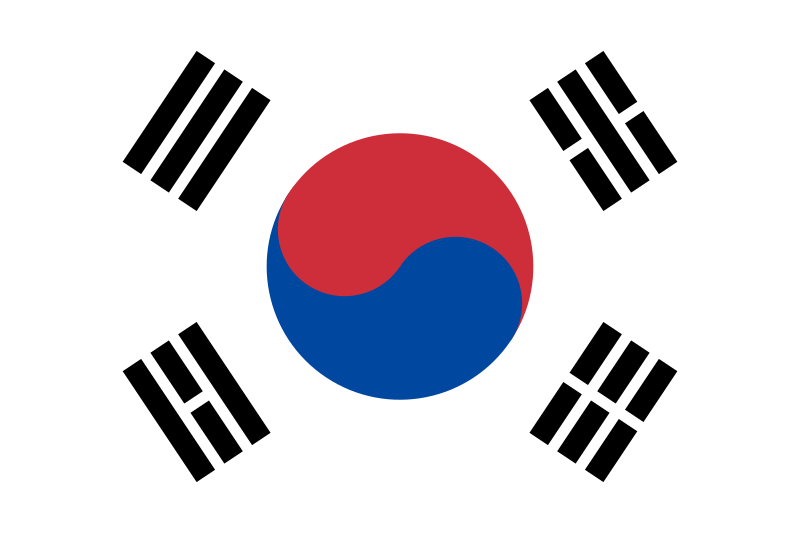



.webp)
.webp)








